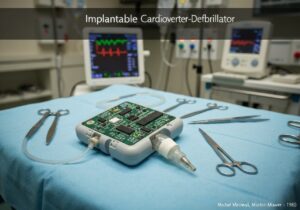Messung der physiologischen Reaktion eines Benutzers auf ein Produkt oder eine Erfahrung.
- Methodologien: Maschinenbau, Qualität
Überwachung der Herzfrequenz

Überwachung der Herzfrequenz
- Kundenerfahrung, Human-Centered Design, Mensch-Computer-Interaktion, Prüfung der Benutzerfreundlichkeit, Benutzererfahrung (UX), Benutzeroberfläche (UI), Benutzer-Tests
Zielsetzung:
Wie es verwendet wird:
- Im Rahmen von Usability-Tests wird die Herzfrequenzmessung verwendet, um den Stress- und Erregungsgrad eines Benutzers bei der Interaktion mit einem Produkt zu messen. Dies kann Einblicke in die emotionale Reaktion des Nutzers geben und dabei helfen, Bereiche der Frustration oder Freude zu identifizieren.
Vorteile
- Liefert objektive Daten über die emotionale Reaktion eines Benutzers; kann Probleme identifizieren, die Benutzer möglicherweise nicht artikulieren.
Nachteile
- Sie können aufdringlich sein und das Verhalten des Benutzers beeinflussen; die Daten können schwer zu interpretieren sein.
Kategorien:
- Ergonomie, Produktdesign
Am besten geeignet für:
- Bewertung der emotionalen Auswirkungen eines neuen Videospiels oder eines stressigen Kassiervorgangs.
Die Überwachung der Herzfrequenz im Rahmen von Usability-Tests findet in einer Reihe von Branchen Anwendung, z. B. in der Spieleindustrie, im E-Commerce und im Gesundheitswesen, wo emotionale Reaktionen die Benutzererfahrung erheblich beeinflussen können. In der Spieleindustrie nutzen die Entwickler diese Methode während der Beta-Tests, indem sie die Herzfrequenzschwankungen der Spieler analysieren, um die Momente höchsten Engagements und potenzieller Frustration während des Spiels zu verstehen und so den Schwierigkeitsgrad oder das Erzähltempo entsprechend anzupassen. Bei E-Commerce-Plattformen ermöglicht die Überwachung der Herzfrequenz während des Bestellvorgangs den Designern, Angstpunkte zu erkennen, die zum Abbruch des Einkaufs führen könnten, und so die Konversionsraten zu maximieren. Im Gesundheitswesen kann die Überwachung der Herzfrequenz beim Testen von Patientenverwaltungssystemen eingesetzt werden, wo sich der emotionale Stress der Benutzer (medizinisches Personal oder Patienten) direkt auf deren Zufriedenheit und Compliance auswirken kann. Diese Methode kann von Usability-Forschern, Produktmanagern oder Designern eingesetzt werden, die objektive Daten zur Ergänzung des qualitativen Feedbacks, das bei herkömmlichen Usability-Tests gesammelt wird, erhalten möchten. Die Teilnehmer können aus verschiedenen demografischen Gruppen stammen, um eine umfassende emotionale Reaktion über verschiedene Segmente hinweg zu erfassen, was ein umfassendes Verständnis der Benutzerinteraktion und -zufriedenheit ermöglicht. Die gesammelten Daten können mit Follow-up-Interviews oder Umfragen kombiniert werden, um einen robusten Evaluierungsprozess zu schaffen, der über rein subjektives Feedback hinausgeht und zu mehr nutzerzentriert Verfeinerung des Designs.
Die wichtigsten Schritte dieser Methodik
- Identifizieren Sie die Aufgabe oder Interaktion, die der Benutzer durchführen wird.
- Messen Sie den Ausgangswert der Herzfrequenz vor der Aufgabe, um eine Kontrolle zu erhalten.
- Überwachen Sie die Herzfrequenz kontinuierlich während der Benutzerinteraktion.
- Identifizieren Sie Spitzen und Tiefpunkte in den Herzfrequenzdaten, um sie mit Benutzeraktionen zu korrelieren.
- Analysieren Sie die Herzfrequenzdaten zusammen mit dem qualitativen Feedback der Teilnehmer.
- Vergleichen Sie emotionale Reaktionen über verschiedene Benutzerinteraktionen oder Testbedingungen hinweg.
Profi-Tipps
- Integrieren Sie Herzfrequenzdaten mit qualitativem Feedback, um Diskrepanzen zwischen körperlichen Reaktionen und der Wahrnehmung des Nutzers aufzudecken.
- Nutzen Sie die zeitsegmentierte Analyse von Herzfrequenzspitzen, um bestimmte Designelemente oder Interaktionen mit emotionalen Reaktionen zu korrelieren.
- Kombinieren Sie Messungen der Herzfrequenzvariabilität mit anderen biometrischen Signalen (z. B. Hautleitwert), um einen ganzheitlichen Überblick über die Emotionen des Benutzers während der Interaktion zu erhalten.
Verschiedene Methoden lesen und vergleichen, Wir empfehlen die
> Umfassendes Methoden-Repository <
zusammen mit den über 400 anderen Methoden.
Ihre Kommentare zu dieser Methodik oder zusätzliche Informationen sind willkommen auf der Kommentarbereich unten ↓ , sowie alle ingenieursbezogenen Ideen oder Links.
Historischer Kontext
1965
1970
1980
1980
1960
1969
1976-05-28
1980
1990
(wenn das Datum nicht bekannt oder nicht relevant ist, z. B. "Strömungsmechanik", wird eine gerundete Schätzung des bemerkenswerten Erscheinens angegeben)









Verwandte Artikel
Monte-Carlo-Simulation
Modellbasiertes Testen
Modellprüfung
Forschung mit gemischten Methoden
Fehlervermeidung (Poka-Yoke)
Prüfung des Missionsprofils